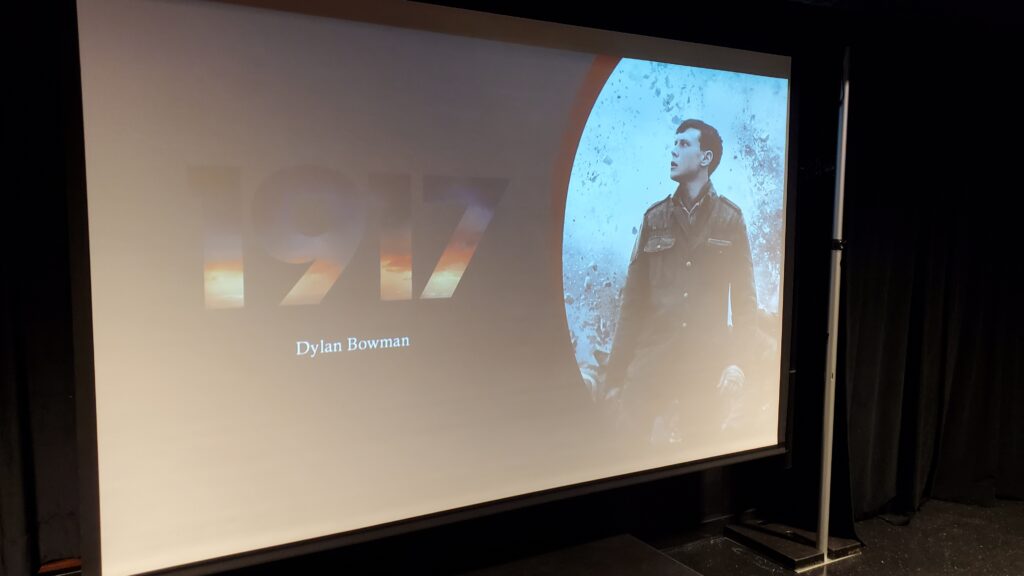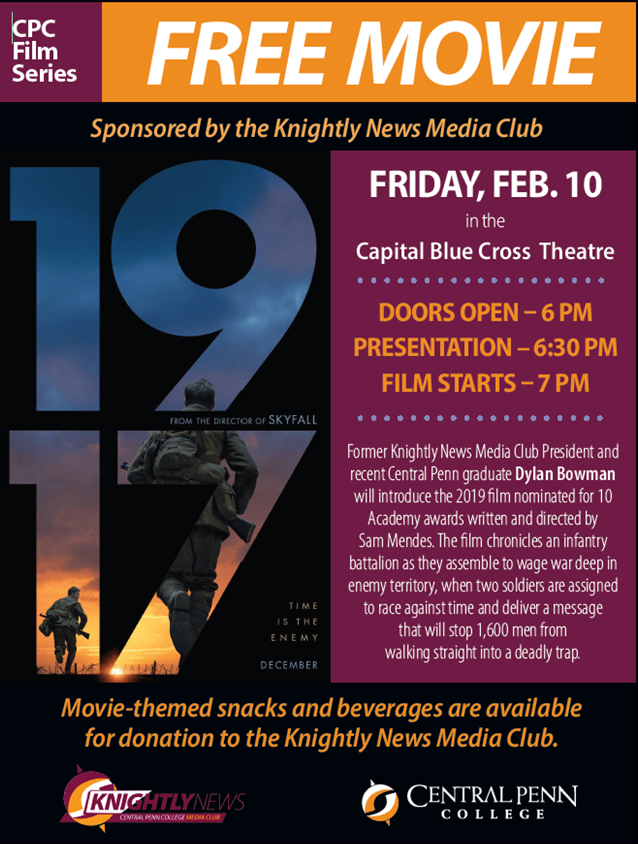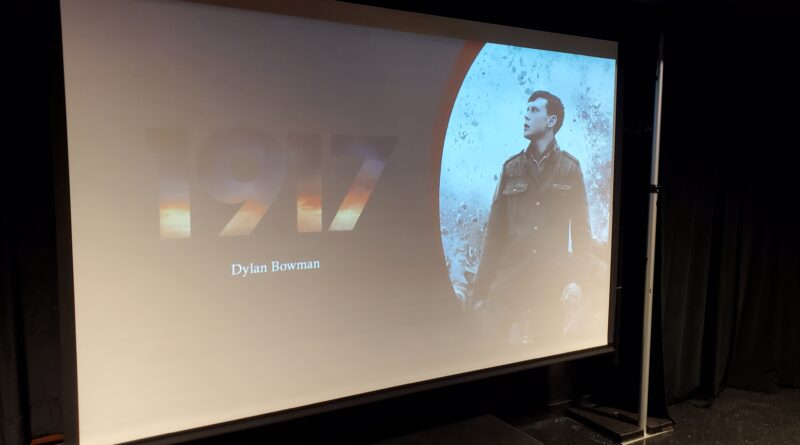Personal connection makes ‘1917’ resonate with presenter at CPC Film Series

By Paul Miller
Knightly News Co-Adviser
and

Nik Hogan
Knightly News Reporter
nikolai.hogan@mymail.centralpenn.edu
Former Knightly News president and recent Central Penn College corporate communications graduate Dylan Bowman took advantage of a wonderful opportunity Friday as he presented the film “1917” in front of a packed house at the quarterly installment of the CPC Film Series in the Capital Blue Cross Theatre at Central Penn College.
During his time at the college, Bowman provided an inspiring template for transfer students. While a student at Central Penn for only six terms that spanned a year and a half, Bowman became the Knightly News Media Club president, CPC Film Series correspondent, Central Penn College athletics photographer, and led the way on a documentary that chronicled the West Shore Connect program and its relationship with Central Penn.
Bowman’s true passion, though, is film, as he has established a production company in the area called Fellowship Studios. With this production company, Bowman has made several films, including “Merciless,” “At War with Myself” and the upcoming “Vintage.” With his experience behind the camera, Bowman considers himself a connoisseur of film, especially in the area of cinematography.

Photo by Paul Miller
What is cinematography?
When one about different aspects of film, average consumers point to the cast, the story or the setting in typical conversations about a film’s merit. But to Bowman, those identifying these areas fail to consider another paramount aspect, the cinematography.
Britannica defines cinematography as “the art and technology of motion-picture photography. It involves such techniques as the general composition of a scene; the lighting of the set or location; the choice of cameras, lenses, filters, and film stock; the camera angle and movements; and the integration of any special effects.” It was these areas that Bowman highlighted in his presentation, specifically how the film “1917” delivered the essence of what this concept is and an example of some of the most visually appealing filmmaking in recent memory.
“1917” is, as Bowman noted in his presentation, as simple a story as a film can have. During World War I, two soldiers are tasked with delivering a message to another battalion concerning information that will surely save thousands of lives. The story itself was not intricate, but the way the film was shot certainly was, as it was created to appear that the entire film was only one shot with no visible cuts. Bowman took major inspiration from this as an amateur filmmaker and seeks to add these types of creative filmmaking skills to his independent films.
Film speaks to people in different ways
When asked why he chose “1917” to present at the CPC Film Series, Bowman stated how this particular film showed him the endless possibilities in the world of filmmaking. Bowman said, “When filmmakers and directors take more risks when creating movies, the outcomes can be incredibly worth the larger amount of effort it takes than following a set formula when creating cinema.”

Near the presentation’s conclusion, Bowman showed the audience a behind-the-scenes video on the making of the movie, allowing the audience a first-hand perspective on how much effort went into the finished product. The movie’s unique filming style was due to director Sam Mendes’ insistence on creating an in-depth and emotional experience. Mendes’ efforts paid off, as the film was nominated for 10 Academy Awards in 2019, winning Oscars in cinematography, visual effects and sound mixing.
Bowman said he loves this movie in its own right as a piece of cinema, but he chose to present it for a reason that hits close to home. His great-great-uncle, Lloyd S. Bowman, served in World War I at the time the film takes place. Despite his relative being stationed in a different area than the film’s protagonists, Bowman saw the similarities between the two main characters in the film and his great-great-uncle, making this movie resonate with him on a personal level.
When asked if he planned to take any specific inspiration to implement into his short films, he said, “The amount of effort and risks it takes to push the boundary and do your own thing far outshines making a simple movie.” He went on to say that he wants to make his films “the absolute best they can be” and how taking his time and putting in all his work can make it a memorable movie and allow it to stand on its own.

It’s showtime!
Even with a relatively straightforward plot, the film managed to keep the audience at full attention. “1917” is a wartime epic that presents as a single continuous shot, showcasing time, tenacity, and suffering. The film follows two soldiers, William Schofield (George MacKay) and Tom Blake (Dean-Charles Chapman), as they embark on a mission to deliver a critical message to a distant battalion. The stakes are high and the situation dire, as the success of their mission will determine the fate of thousands of troops, including Blake’s brother. The film masterfully showcases the immediacy and persistence of battle through its unique cinematography — the appearance of having been made in one continuous shot in real time.
Almost across the board, critics have beamed about the film, but one quote that resonated was from Sean Collier from Pittsburgh Magazine. “This is a movie one does not watch so much as witness,” Collier wrote. “It simply must be seen.”
Watching the Oscar-nominated film in the Capital Blue Cross Theatre, the entire audience was silent and engaged from the opening to the end credits of the movie — a testament that cinema is and will forever be an important facet of human culture. But it was Bowman who threaded the needle in his pre-film presentation, allowing the audience to learn more about the art of filmmaking and the impact that shot compositions, camera angles and other visual effects can have on viewers.
This event speaks to the essence of the CPC Film Series, bringing in different people from a variety of perspectives to speak about their connection to film, while educating audiences on the vast nuance of the medium. Film, in a general sense, can be enjoyed on a variety of levels. It might keep a person company on a snowy afternoon or make a person laugh after a long day at the office. But to truly experience film in its totality is to unlock the depth and beauty of the medium through a shared understanding and appreciation with others. This shared experience is what the CPC Film Series strives to offer its attendees and hopes to continue doing.
If you have questions about the CPC Film Series or upcoming presenters, contact Professor Paul Miller at paulmiller@centralpenn.edu.
Have a comment about this story or do you have a story idea? Contact KnightlyEditors@CenrtralPenn.Edu. Edited by media-club co-adviser and blog editor Professor Michael Lear-Olimpi.




